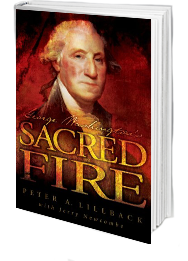Providence Today: William Penn & Christ Church
Dr. Peter A. Lillback:
This is Providence Today. We’re here in Philadelphia, and we’re standing by the historic Christ Church. Christ Church is a historic Anglican Church, and it’s the birthplace of the modern Episcopal Church. It was hard to be a church of England after the American revolution, as you can well understand. And so the church renamed itself as the Bishop’s Church. That’s what the word episkopos in Greek means. So in English, Episcopal, the Bishop’s Church. Now, the story that’s here is remarkable because this becomes, if you will, in one sense, the National Cathedral of the United States in the time of the early American revolution. The Congress would meet here from time to time for special events. It’s also a place where the values that are so important to the American spirit were well celebrated.
Dr. Peter A. Lillback:
You can go inside and see the reredos, the reredos that has the 10 Commandments written on the wall, the Lord’s prayer. These are the values, like the Apostles’ Creed, that our founders all understood helping to shape their story. But there’s one thing that is really beautiful about this place that is not immediately evident unless you know something of the story of William Penn, the founder of Philadelphia. He named his city from the Bible, and the city’s name Philadelphia from the ancient world brought here means a place where brothers love is celebrated. William Penn chose that name because he wanted Philadelphia to be a place where brothers would love each other in spite of their religious differences. He wanted there to be enough, a reflective piece toward each group, a toleration and liberty of different consciences that would allow each to worship, but there’d be a common civil government.
Dr. Peter A. Lillback:
When William Penn was in England, the Anglican Church actually put him in the Tower of London because he is a Quaker Street preacher. It’s illegal to preach on street. It’s illegal to preach without a license from the king. And he went to jail. And he had this idea, “What would the world look like if there could be a place where civil liberties were protected and there was still a common civil society?” Well, the opportunity came when a great debt to his family was paid by King Charles’s II in land we call today Pennsylvania, Penn’s Woods, this vast tract of land. This is where Philadelphia is. And so when settlers came to the new city, some of them were Anglicans. The very people that put William Penn in jail were now allowed to come and have liberty in his city, and they built one of the most beautiful buildings in the entire new world. In fact, this building with its steeple was the highest place in America, I think, for over a century.
Dr. Peter A. Lillback:
And so William Penn put it this way, the liberty we want for ourselves, we must give to others. That was the golden rule. When William Penn wrote his book on The Freedom of the Conscience, he put on his cover Matthew 7:12, “Do unto others as you’d have them do unto you.” Religious liberty applied to the public square was applied by a minister of the gospel named William Penn, and that allowed even the Anglicans who had given William Penn a very difficult time in London to build this beautiful building that then becomes, if you will, as we’ve said, the National Cathedral of the early continental Congress. If you enjoy this opportunity to learn more about our founding era here in Philadelphia, get the Faith & Freedom app from the Providence Forum. It’s free, downloadable from the Apple Store. We urge you to get it and take a virtual tour wherever you are. Share it with your friends. Another thing you can do is to go to our website with a great deal of wonderful material. It’s found at providenceforum.org. So thanks for your interest, and this is Providence Today.
